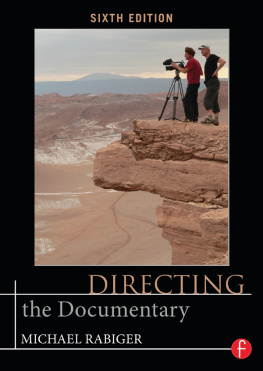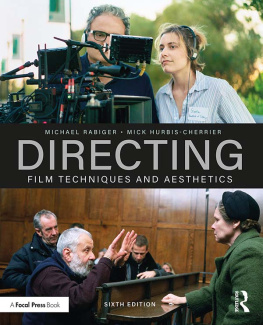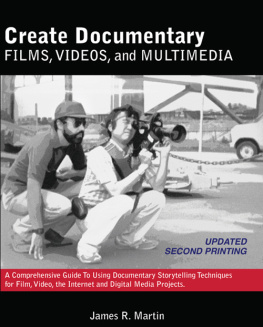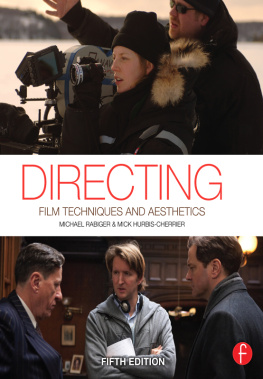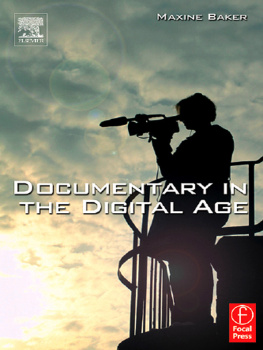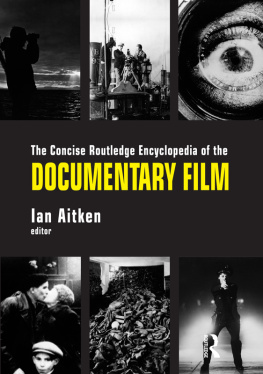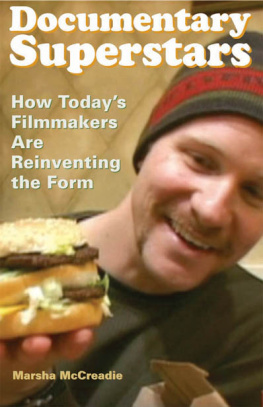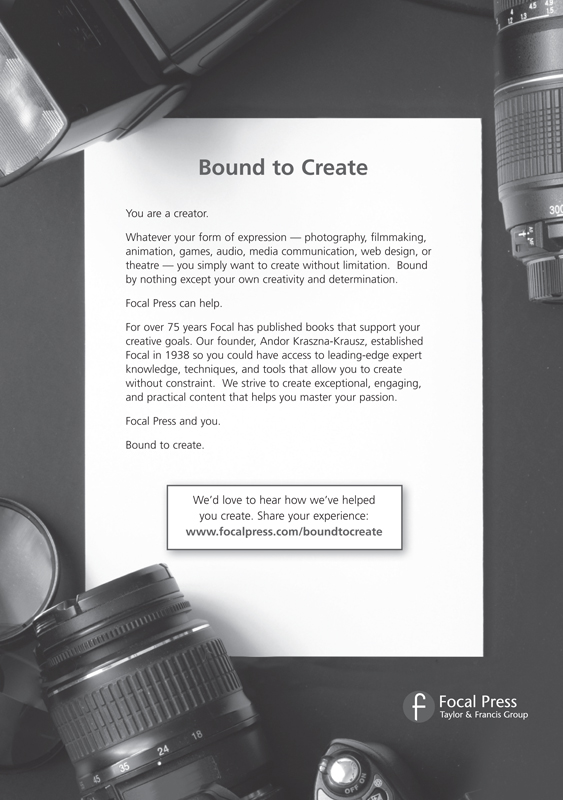DIRECTING THE DOCUMENTARY
Sixth Edition
DIRECTING THE DOCUMENTARY
Sixth Edition
Michael Rabiger
First published 1987
by Focal Press
This edition published 2015
by Focal Press
70 Blanchard Road, Suite 402, Burlington, MA 01803
and by Focal Press
2 Park Square, Milton Park, Abingdon, Oxon OX14 4RN
Focal Press is an imprint of the Taylor & Francis Group, an informa business
2015 Taylor & Francis
The right of Michael Rabiger to be identified as author of this work has been asserted by him in accordance with sections 77 and 78 of the Copyright, Designs and Patents Act 1988.
All rights reserved. No part of this book may be reprinted or reproduced or utilized in any form or by any electronic, mechanical, or other means, now known or hereafter invented, including photocopying and recording, or in any information storage or retrieval system, without permission in writing from the publishers.
Notices
Knowledge and best practice in this field are constantly changing. As new research and experience broaden our understanding, changes in research methods, professional practices, or medical treatment may become necessary.
Practitioners and researchers must always rely on their own experience and knowledge in evaluating and using any information, methods, compounds, or experiments described herein. In using such information or methods they should be mindful of their own safety and the safety of others, including parties for whom they have a professional responsibility.
Product or corporate names may be trademarks or registered trademarks, and are used only for identification and explanation without intent to infringe.
Library of Congress Cataloging in Publication Data
Rabiger, Michael.
Directing the documentary / Michael Rabiger. -- Sixth edition.
pages cm
Includes bibliographical references and index.
1. Documentary filmsProduction and direction. I. Title.
PN1995.9.D6R33 2014
070.1'8dc23
2014011982
ISBN: 978-0-415-71930-8 (pbk)
ISBN: 978-1-315-86750-2 (ebk)
Typeset in Sabon LT Std
By MPS Limited, Chennai, India
In loving memory of my sister Lindsey
TABLE OF CONTENTS
Today people are shooting actuality as never before, using consumer cameras to shoot friends, children, or pets, and smartphones to cover demonstrations or document the retribution meted out by security forces. On the front lines of human conflict, courageous men and women risk their lives to document war and natural disasters that turn human life into an atrocious struggle. This they do, I believe, because something noble and brave in them believes that people should not suffer alone. The resulting torrent of documentariescommitted, quirky, funny, outrageous, and sometimes horrificcreates an appetite not only to see films reflecting reality, but to make them.
Which is where this how-to book comes in. Today, anyone can make a documentary, and to save you having to reinvent the wheel, here is my half-century of experience in filmmaking and teaching for you to use. I will talk to you as an equal, and give you a reliable path to follow while you figure out your own esoteric ways of operating. Dont be intimidatedthe book is not meant as a survival course, but as a cornucopia of resources from which you choose according to your temperament and current needs. Start filmmaking immediately: you learn filmmaking best from doing it.
DIRECTING THE DOCUMENTARYS WEBSITE
To keep the book portable (a big complaint with the last edition), many of its suggested projects are now downloadable from following this preface for what the website offers. You will find analysis, development, shooting, and postproduction projects, as well as short film examples, logs, and forms to help you during production.
PLANNING TO EXCEL
The resources to make nonfiction film are now widely accessible, which means you face stiff competition if you want to make documentary your career. If your films are to cross national and linguistic frontiers, you will need to think originally and in terms of pictorial narrative rather than the radio with pictures that television has long given us. A film is really a subtly controlled stream of consciousness for an audience, so I shall often remind you that work which is fresh and personal comes from valuing the primacy of your own life-experience. By learning to notice how you receive and process powerful impressions, you will learn how to use the screen not only personally, but effectively, universally, and accessibly.
If you are lucky and have an experienced mentor, he or she will undoubtedly explain or rationalize some aspects of documentary differently from me. This is because making films is an art, not a science. My way is not the way, but a path for you to use as you move toward reliance on your own stock of filmmaking experiencethe ultimate and truest authority of all.
As you gain in abilities, please share your skills, ideas, and discoveries with anyone interested. The best way to develop is always to try teaching it to someone else.
This new edition has a top-to-bottom, revised, and clarified structure that aims to put best practice information in your hands. Locate anything quickly using the comprehensive table of Contents at the front, where you see that this book is in fact two booksone for each of the major learning phases it takes to become an accomplished storyteller.
First, like an aspiring musician, you practice to master todays digital instrumentsthe camera and the editing programto document personalities and events that develop spontaneously and outside your control. This relatively self-effacing form of authorship suits many temperaments (mine included), and can produce documentaries of high potential as art and social observation. The Parts include:
helps you articulate your own most valuable potentialthe marks your life has made on you. The aim is to define your own particular thematic material, and to confirm the values and convictions that are your documentarians wellsprings.
describes how documentary expression evolved in tandem with its technology, and how each new form of documentary sets about making a revised construct of reality. The text demystifies film language by showing that techniques of camerawork and editing in fact mimic human habits of perception and physical adaptation.
covers the pre-shooting stages when you begin to look for, assess, and develop documentary ideas. To solicit audience feedback at an early stage, you develop a working hypothesis, then research, write a proposal, and pitch (make an oral presentation of) the film idea to listeners. From their reactions, you develop your film approach.
outlines the fundamentals of observational filmmaking, along with the technology and techniques of basic lighting, capturing clear sound, and producing fluid, engaged camerawork. This section also deals with the collaborative practices of film teamwork.
covers the highly creative processes of editing, and describes the critical viewing sessions of dailies (uncut material just as the camera shot it). You then find a structure and proper duration for your film, produce a smooth, well-paced cut, and seek feedback from test audiences.
Graduating to longer and more complex films means working hard to attract and hold an audiences attention. Films of all kinds need not just a good subject, but the style, purpose, and voice of an entertaining storyteller. This involves self-knowledge as well as planning your films aesthetics and narrative style. It further means seeking to control all the logistical and technical requirements at a high level of professionalism. Almost certainly you will use a more intercessional style of filmmaking to do this.
Next page
